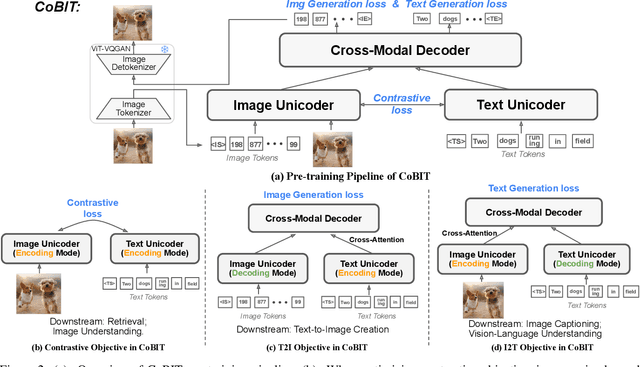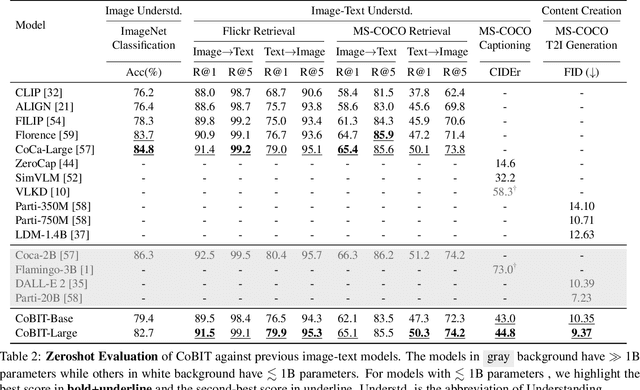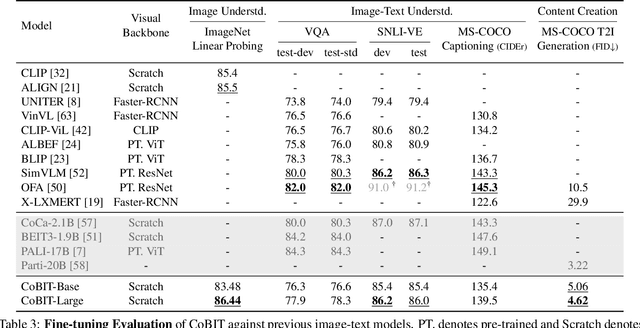Jason Baldridge
Imagen 3
Aug 13, 2024Abstract:We introduce Imagen 3, a latent diffusion model that generates high quality images from text prompts. We describe our quality and responsibility evaluations. Imagen 3 is preferred over other state-of-the-art (SOTA) models at the time of evaluation. In addition, we discuss issues around safety and representation, as well as methods we used to minimize the potential harm of our models.
Into the Unknown: Generating Geospatial Descriptions for New Environments
Jun 28, 2024Abstract:Similar to vision-and-language navigation (VLN) tasks that focus on bridging the gap between vision and language for embodied navigation, the new Rendezvous (RVS) task requires reasoning over allocentric spatial relationships (independent of the observer's viewpoint) using non-sequential navigation instructions and maps. However, performance substantially drops in new environments with no training data. Using opensource descriptions paired with coordinates (e.g., Wikipedia) provides training data but suffers from limited spatially-oriented text resulting in low geolocation resolution. We propose a large-scale augmentation method for generating high-quality synthetic data for new environments using readily available geospatial data. Our method constructs a grounded knowledge-graph, capturing entity relationships. Sampled entities and relations (`shop north of school') generate navigation instructions via (i) generating numerous templates using context-free grammar (CFG) to embed specific entities and relations; (ii) feeding the entities and relation into a large language model (LLM) for instruction generation. A comprehensive evaluation on RVS, showed that our approach improves the 100-meter accuracy by 45.83% on unseen environments. Furthermore, we demonstrate that models trained with CFG-based augmentation achieve superior performance compared with those trained with LLM-based augmentation, both in unseen and seen environments. These findings suggest that the potential advantages of explicitly structuring spatial information for text-based geospatial reasoning in previously unknown, can unlock data-scarce scenarios.
ImageInWords: Unlocking Hyper-Detailed Image Descriptions
May 05, 2024Abstract:Despite the longstanding adage "an image is worth a thousand words," creating accurate and hyper-detailed image descriptions for training Vision-Language models remains challenging. Current datasets typically have web-scraped descriptions that are short, low-granularity, and often contain details unrelated to the visual content. As a result, models trained on such data generate descriptions replete with missing information, visual inconsistencies, and hallucinations. To address these issues, we introduce ImageInWords (IIW), a carefully designed human-in-the-loop annotation framework for curating hyper-detailed image descriptions and a new dataset resulting from this process. We validate the framework through evaluations focused on the quality of the dataset and its utility for fine-tuning with considerations for readability, comprehensiveness, specificity, hallucinations, and human-likeness. Our dataset significantly improves across these dimensions compared to recently released datasets (+66%) and GPT-4V outputs (+48%). Furthermore, models fine-tuned with IIW data excel by +31% against prior work along the same human evaluation dimensions. Given our fine-tuned models, we also evaluate text-to-image generation and vision-language reasoning. Our model's descriptions can generate images closest to the original, as judged by both automated and human metrics. We also find our model produces more compositionally rich descriptions, outperforming the best baseline by up to 6% on ARO, SVO-Probes, and Winoground datasets.
DOCCI: Descriptions of Connected and Contrasting Images
Apr 30, 2024



Abstract:Vision-language datasets are vital for both text-to-image (T2I) and image-to-text (I2T) research. However, current datasets lack descriptions with fine-grained detail that would allow for richer associations to be learned by models. To fill the gap, we introduce Descriptions of Connected and Contrasting Images (DOCCI), a dataset with long, human-annotated English descriptions for 15k images that were taken, curated and donated by a single researcher intent on capturing key challenges such as spatial relations, counting, text rendering, world knowledge, and more. We instruct human annotators to create comprehensive descriptions for each image; these average 136 words in length and are crafted to clearly distinguish each image from those that are related or similar. Each description is highly compositional and typically encompasses multiple challenges. Through both quantitative and qualitative analyses, we demonstrate that DOCCI serves as an effective training resource for image-to-text generation -- a PaLI 5B model finetuned on DOCCI shows equal or superior results compared to highly-performant larger models like LLaVA-1.5 7B and InstructBLIP 7B. Furthermore, we show that DOCCI is a useful testbed for text-to-image generation, highlighting the limitations of current text-to-image models in capturing long descriptions and fine details.
Where Do We Go from Here? Multi-scale Allocentric Relational Inference from Natural Spatial Descriptions
Feb 26, 2024Abstract:When communicating routes in natural language, the concept of {\em acquired spatial knowledge} is crucial for geographic information retrieval (GIR) and in spatial cognitive research. However, NLP navigation studies often overlook the impact of such acquired knowledge on textual descriptions. Current navigation studies concentrate on egocentric local descriptions (e.g., `it will be on your right') that require reasoning over the agent's local perception. These instructions are typically given as a sequence of steps, with each action-step explicitly mentioning and being followed by a landmark that the agent can use to verify they are on the right path (e.g., `turn right and then you will see...'). In contrast, descriptions based on knowledge acquired through a map provide a complete view of the environment and capture its overall structure. These instructions (e.g., `it is south of Central Park and a block north of a police station') are typically non-sequential, contain allocentric relations, with multiple spatial relations and implicit actions, without any explicit verification. This paper introduces the Rendezvous (RVS) task and dataset, which includes 10,404 examples of English geospatial instructions for reaching a target location using map-knowledge. Our analysis reveals that RVS exhibits a richer use of spatial allocentric relations, and requires resolving more spatial relations simultaneously compared to previous text-based navigation benchmarks.
Gemini: A Family of Highly Capable Multimodal Models
Dec 19, 2023Abstract:This report introduces a new family of multimodal models, Gemini, that exhibit remarkable capabilities across image, audio, video, and text understanding. The Gemini family consists of Ultra, Pro, and Nano sizes, suitable for applications ranging from complex reasoning tasks to on-device memory-constrained use-cases. Evaluation on a broad range of benchmarks shows that our most-capable Gemini Ultra model advances the state of the art in 30 of 32 of these benchmarks - notably being the first model to achieve human-expert performance on the well-studied exam benchmark MMLU, and improving the state of the art in every one of the 20 multimodal benchmarks we examined. We believe that the new capabilities of Gemini models in cross-modal reasoning and language understanding will enable a wide variety of use cases and we discuss our approach toward deploying them responsibly to users.
Davidsonian Scene Graph: Improving Reliability in Fine-grained Evaluation for Text-to-Image Generation
Oct 30, 2023



Abstract:Evaluating text-to-image models is notoriously difficult. A strong recent approach for assessing text-image faithfulness is based on QG/A (question generation and answering), which uses pre-trained foundational models to automatically generate a set of questions and answers from the prompt, and output images are scored based on whether these answers extracted with a visual question answering model are consistent with the prompt-based answers. This kind of evaluation is naturally dependent on the quality of the underlying QG and QA models. We identify and address several reliability challenges in existing QG/A work: (a) QG questions should respect the prompt (avoiding hallucinations, duplications, and omissions) and (b) VQA answers should be consistent (not asserting that there is no motorcycle in an image while also claiming the motorcycle is blue). We address these issues with Davidsonian Scene Graph (DSG), an empirically grounded evaluation framework inspired by formal semantics. DSG is an automatic, graph-based QG/A that is modularly implemented to be adaptable to any QG/A module. DSG produces atomic and unique questions organized in dependency graphs, which (i) ensure appropriate semantic coverage and (ii) sidestep inconsistent answers. With extensive experimentation and human evaluation on a range of model configurations (LLM, VQA, and T2I), we empirically demonstrate that DSG addresses the challenges noted above. Finally, we present DSG-1k, an open-sourced evaluation benchmark that includes 1,060 prompts, covering a wide range of fine-grained semantic categories with a balanced distribution. We release the DSG-1k prompts and the corresponding DSG questions.
Gaussian Process Probes (GPP) for Uncertainty-Aware Probing
May 29, 2023



Abstract:Understanding which concepts models can and cannot represent has been fundamental to many tasks: from effective and responsible use of models to detecting out of distribution data. We introduce Gaussian process probes (GPP), a unified and simple framework for probing and measuring uncertainty about concepts represented by models. As a Bayesian extension of linear probing methods, GPP asks what kind of distribution over classifiers (of concepts) is induced by the model. This distribution can be used to measure both what the model represents and how confident the probe is about what the model represents. GPP can be applied to any pre-trained model with vector representations of inputs (e.g., activations). It does not require access to training data, gradients, or the architecture. We validate GPP on datasets containing both synthetic and real images. Our experiments show it can (1) probe a model's representations of concepts even with a very small number of examples, (2) accurately measure both epistemic uncertainty (how confident the probe is) and aleatory uncertainty (how fuzzy the concepts are to the model), and (3) detect out of distribution data using those uncertainty measures as well as classic methods do. By using Gaussian processes to expand what probing can offer, GPP provides a data-efficient, versatile and uncertainty-aware tool for understanding and evaluating the capabilities of machine learning models.
CoBIT: A Contrastive Bi-directional Image-Text Generation Model
Mar 23, 2023



Abstract:The field of vision and language has witnessed a proliferation of pre-trained foundation models. Most existing methods are independently pre-trained with contrastive objective like CLIP, image-to-text generative objective like PaLI, or text-to-image generative objective like Parti. However, the three objectives can be pre-trained on the same data, image-text pairs, and intuitively they complement each other as contrasting provides global alignment capacity and generation grants fine-grained understanding. In this work, we present a Contrastive Bi-directional Image-Text generation model (CoBIT), which attempts to unify the three pre-training objectives in one framework. Specifically, CoBIT employs a novel unicoder-decoder structure, consisting of an image unicoder, a text unicoder and a cross-modal decoder. The image/text unicoders can switch between encoding and decoding in different tasks, enabling flexibility and shared knowledge that benefits both image-to-text and text-to-image generations. CoBIT achieves superior performance in image understanding, image-text understanding (Retrieval, Captioning, VQA, SNLI-VE) and text-based content creation, particularly in zero-shot scenarios. For instance, 82.7% in zero-shot ImageNet classification, 9.37 FID score in zero-shot text-to-image generation and 44.8 CIDEr in zero-shot captioning.
Imagen Editor and EditBench: Advancing and Evaluating Text-Guided Image Inpainting
Dec 13, 2022



Abstract:Text-guided image editing can have a transformative impact in supporting creative applications. A key challenge is to generate edits that are faithful to input text prompts, while consistent with input images. We present Imagen Editor, a cascaded diffusion model built, by fine-tuning Imagen on text-guided image inpainting. Imagen Editor's edits are faithful to the text prompts, which is accomplished by using object detectors to propose inpainting masks during training. In addition, Imagen Editor captures fine details in the input image by conditioning the cascaded pipeline on the original high resolution image. To improve qualitative and quantitative evaluation, we introduce EditBench, a systematic benchmark for text-guided image inpainting. EditBench evaluates inpainting edits on natural and generated images exploring objects, attributes, and scenes. Through extensive human evaluation on EditBench, we find that object-masking during training leads to across-the-board improvements in text-image alignment -- such that Imagen Editor is preferred over DALL-E 2 and Stable Diffusion -- and, as a cohort, these models are better at object-rendering than text-rendering, and handle material/color/size attributes better than count/shape attributes.
 Add to Chrome
Add to Chrome Add to Firefox
Add to Firefox Add to Edge
Add to Edge